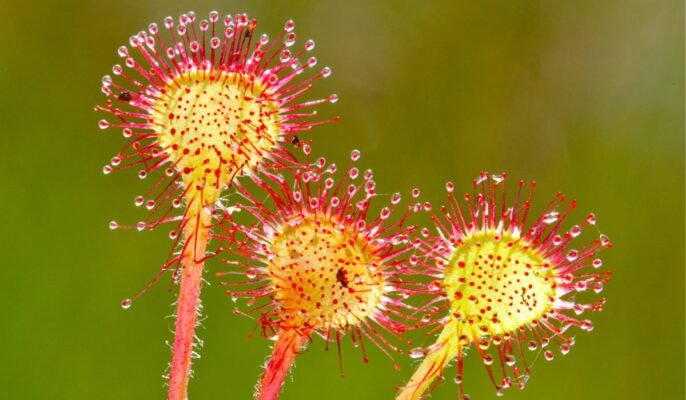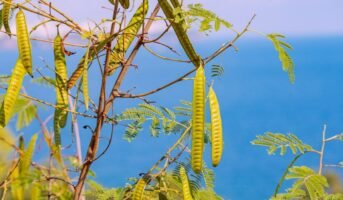sSundews are carnivorous plants, and their attractive and colourful traps make them popular as ornamental plants in gardens. The plant is among the 152 carnivorous plant species of the Droseraceae family. One of the peculiar features of the plant is its long tentacles protruding from leaves with a sticky gland at the tip. This gives an impression of dew-like droplets shining in the Sun, hence the name Sundew. The plant leaves have long tentacles, and their tips contain nectar that traps insects.
See also: Is Venus Flytrap an apt house plant?
Sundew plant: Quick facts
| Plant name | Sundews |
| Common names | Drosera |
| Family | Droseraceae |
| Found in | All continents except Antarctica |
| Flower | White or pink |
| Foliage | Fringed leaves |
| Benefits | Ornamental purpose |
know about: aphids bugs
What is a Sundew plant?
Sundews, also referred by the name Drosera, belongs to the large class of carnivorous plant comprising at least 194 species. It belongs to the Droseraceae family, which typically lure, capture and digest insects through stalked mucilaginous glands covering their leaf surfaces. The insects fulfil the mineral nutrition of the soil for the plant’s growth. Several species of the plant, vary significantly in size and form.
Sundew plant: Description
- Sundews are perennial, herbaceous plants, which form prostrate or upright rosettes ranging in the height of 1 and 100 cm (0.39 and 39.37 inches), depending on the species.
- The plant is widely distributed across tropical and temperate areas.
- The sticky glands on the tip of tentacles produce nectar to attract and trap its prey and contain enzymes to digest it.
- It is a perennial plant that produces five-petaled flowers on a curving stem around 10 cm to 25 cm above the basal leaves.
- The leaves, less than an inch in diameter, are typically arranged in a rosette.
- On the top surface, the plant hair has sticky glands, or tentacles that entrap insects and small prey.
- The flower buds of Sundew plant grow on a stalk, supporting three to over 20 flowers.
- Sundew plants grow up to a height of around ten inches. Some of the species have a vine-like appearance, while some hug the ground, having variable sizes.
Sundew plant: Species
There are over 100 species of sundews that thrive in temperate and tropical regions across the world. Some varieties require cross-pollination and reproduce through seeds, while many self-pollinate.
The group is divided into several habits, or growth forms:
Temperate sundews
The species appears as a tight cluster of unfurled leaves known as a hibernaculum in dormancy period in winter. All North American and European species fall under this group.
Subtropical sundews
The species sustain vegetative growth all throughout the year in uniform or nearly uniform climatic conditions.
Pygmy sundews
A group of around 40 Australian species, Pygmy sundews are distinguished by miniature growth, the formation of gemmae for asexual reproduction, and dense formation of hairs in the crown center. The hairs protect the plants from intense summer sun. The species form the subgenus Bryastrum.
Tuberous sundews
There are around 50 Australian species forming an underground tuber to survive the extremely dry summers of their habitat, re-emerging in the autumn. Tuberous sundews are classified into two groups, which form rosettes and the ones that form climbing or scrambling stems. The species comprise the subgenus Ergaleium.
Petiolaris complex
This is a group of tropical Australian species that thrive in warm but sometimes wet climatic conditions. Most of the 14 species comprise this group consist of developed special strategies to cope with alternately drier conditions. Some have petioles densely covered in trichomes, which maintain proper humid environment and act as an increased condensation surface for morning dew.
Queensland sundews
A small group of three species, this group is native to highly humid regions in the dim understories of rainforests in Australia.
Sundew plant: Care and maintenance tips
- Sunlight: The plant needs partial to full sunlight.
- Temperature: The ideal temperature requirement for the plant is 16-24 degrees Celsius.
- Watering: Sundews require frequent watering.
- Soil: Soil must have acidic pH. Use a 1:1 mix of peat moss and sand/perlite for the plant.
- Fertiliser: The plant feeds on insects and does not require fertiliser.
Read also: Insect Eating Plants: Know all about Carnivorous plants in 2023
How does a sundew plant eat insects?
The glands of the sundew plant produce nectar that attracts prey. Once the prey gets stuck to it, the tentacles coil around the prey and strangle it. Sundews can kill trapped prey in around 15 minutes and digest it for over a few weeks.
How to grow Sundew plant?
Sundew plants can be grown in pots, indoors and outdoors. In optimum growing conditions of heat and humidity levels, creating a tropical condition, the plant can be easily grown in any home garden.
The plants sometimes grow above sphagnum moss, a type of moss found in commercial peat moss. The plants typically must be purchased from suppliers specialising in exotic indoor plants.
Sundew plant: Common problems
There are only a few issues that affect sundew plants. There are some common pests and ailments that can sometimes affect the plant.
- Mosquito-like gnats around plants can denote fungus gnat infestation. The gnats are attracted to damp soil where they lay their eggs. Several species of fungus gnats are a part of the Sciaridae and Mycetophilidae families. These are attracted to bog plants like sundew because of the wet soil they grow best in.
- Aphids is one of the common insects that affect Sundew plants. Some of the symptoms of the insect-infestation is curling or dying leaves, discoloration, or stunting of the plant.
FAQs
Are sundews poisonous?
Sundew plants are non-poisonous to pets and humans. They help keep a check on insects in gardens.
What are the uses of Sundew plants?
Dried sundews are used in making medicine and has been known to cure medical conditions such as asthma, bronchitis, whooping cough (pertussis), cancer, etc.
Harini is a content management professional with over 12 years of experience. She has contributed articles for various domains, including real estate, finance, health and travel insurance and e-governance. She has in-depth experience in writing well-researched articles on property trends, infrastructure, taxation, real estate projects and related topics. A Bachelor of Science with Honours in Physics, Harini prefers reading motivational books and keeping abreast of the latest developments in the real estate sector.

